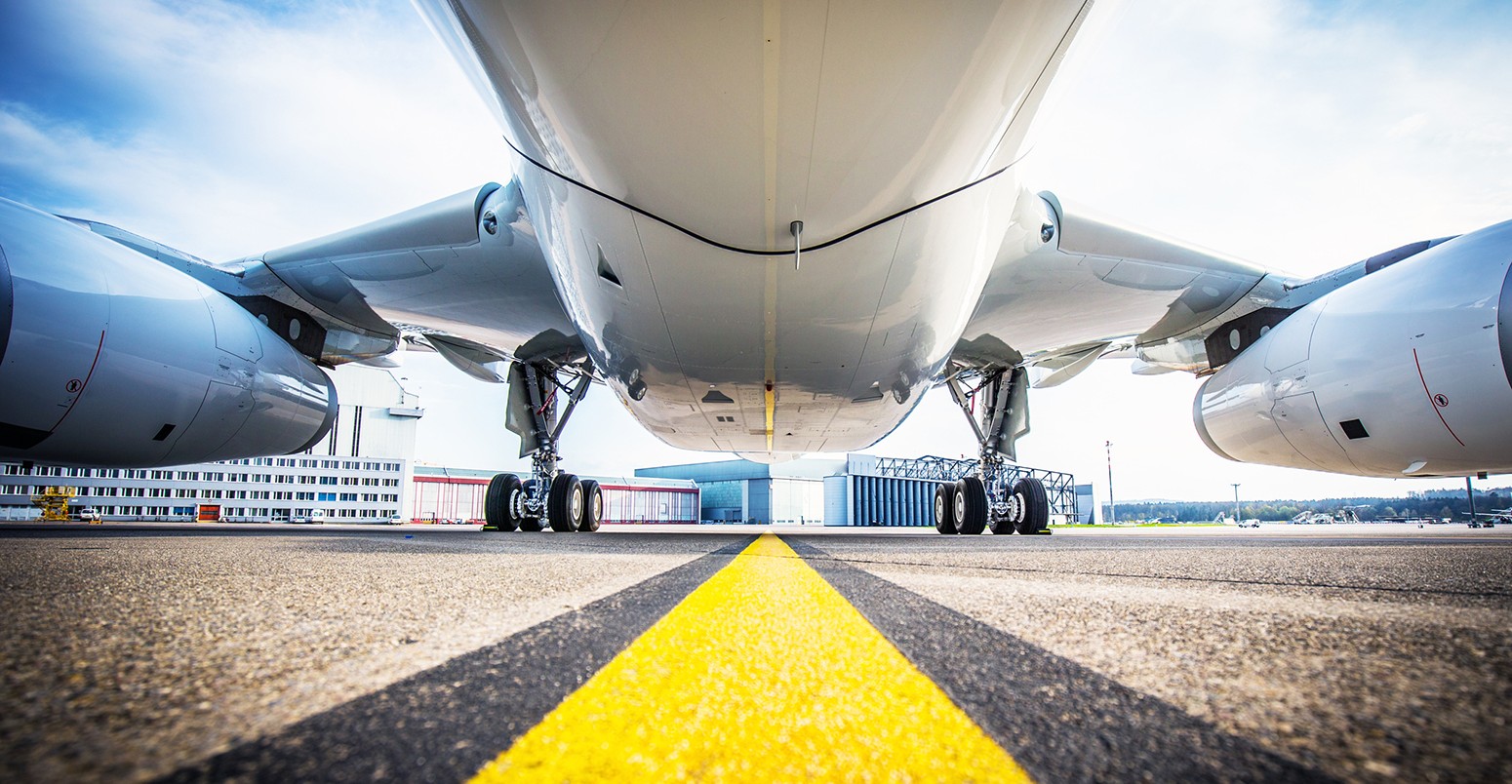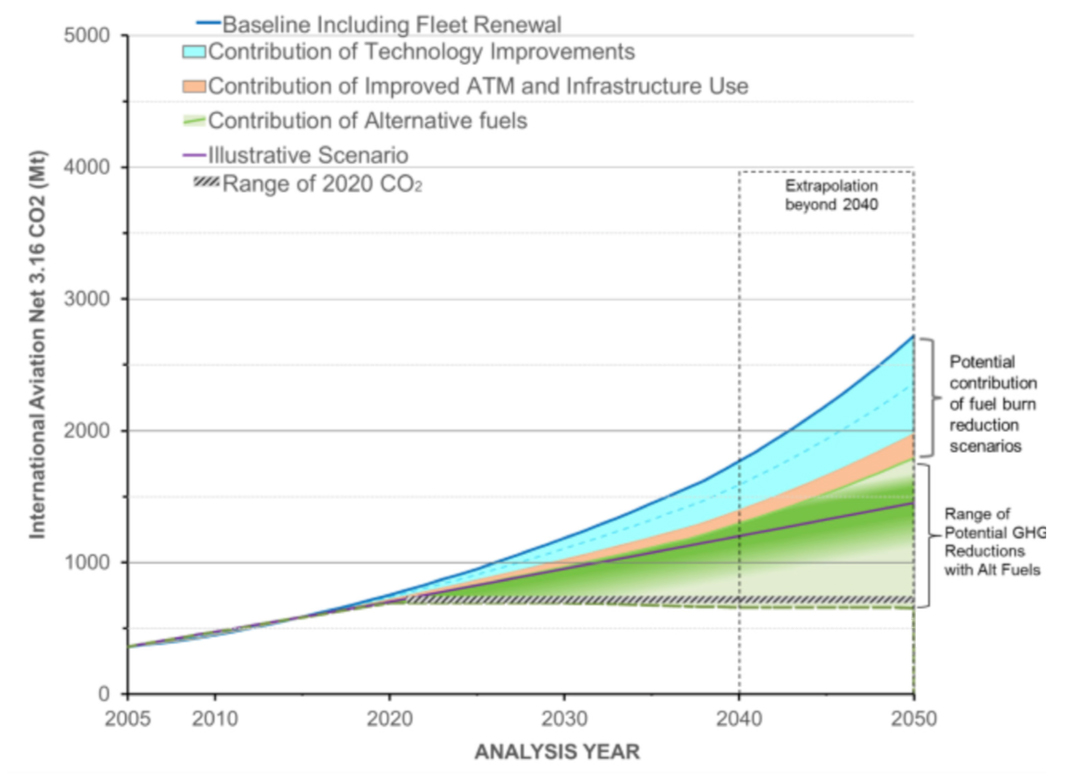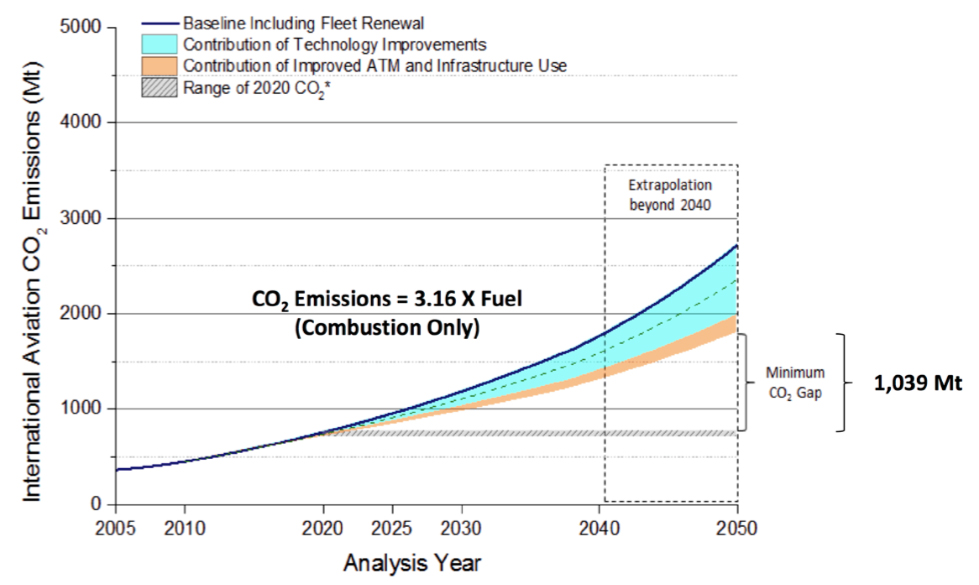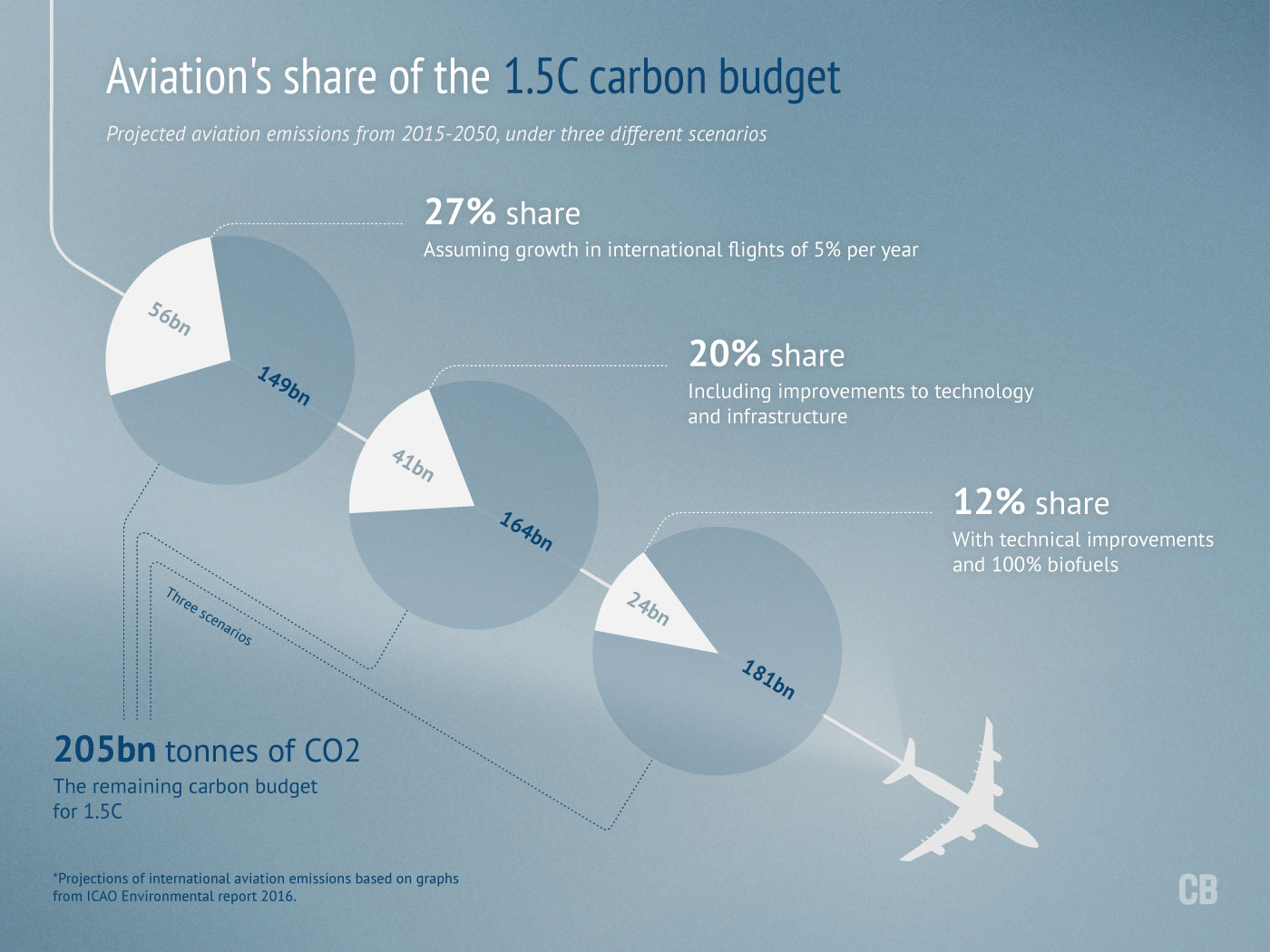
Analysis: Aviation could consume a quarter of 1.5C carbon budget by 2050
Multiple Authors
08.08.16Multiple Authors
08.08.2016 | 6:35amThe aviation industry faces huge challenges if it is to meet its own self-imposed climate change targets, according to a new UN report.
And even if it does meet all its targets, aviation will still have consumed 12% of the global carbon budget for 1.5C by 2050, Carbon Brief analysis shows. If it fails to reach this target, its share of this budget could rise to as much as 27%.
The sector has an aspirational goal to cap its emissions at 2020 levels, so that any growth after this year is achieved in a “carbon neutral” way.
This will not be easy. Airlines estimate that air travel will grow by an average of just under 5% per year up to 2034 — and the emissions from these extra air miles will be difficult to decarbonise.
Technology improvements
The International Civil Aviation Authority (ICAO), the UN body for flying, has set out the difficulties of cutting emissions in a growing sector in its 2016 Environmental Report, which is released every three years.
The UN report forecasts the greenhouse gas emissions of the aviation sector out to 2050, and looks at how they could be reduced. The following chart shows the extent to which improvements to the aviation sector itself could help to cut emissions.

Aircraft CO2 emissions from International Aviation, 2005-2050. Updated to include alternative fuels life cycle emissions reductions. Dashed line represents effect on net CO2 emissions association with the 100% replacement of jet fuel with alternatives by 2050. 100% replacement of alternative jet fuel would requite a complete shifting in aviation from petroleum refining to biofuel production and a substantial expansion of the agricultural sector, both of which would require substantial policy support. Illustrative case would require high availability of bioenergy feedstocks, the production of which is significantly incentivised by price or other policy mechanisms. Source: ICAO 2016 Environmental Report
Under a business-as-usual projection, where the aviation industry grows by 5% per year, but there are no major changes to technology or infrastructure, total emissions over the period 2015-2050 reach approximately 56bn tonnes of CO2 (area under dark blue line).
The rate of emissions in 2050 has been revised downwards from ICAO’s previous environmental report three years ago, but it appears that they have also scaled down the potential for technological improvements to the industry.
Carbon Brief asked Dr Joeri Rogelj, one of the world’s leading experts on carbon budgets, to express the latest projections in terms of the internationally agreed climate targets adopted in Paris last year — to keep global temperature rise to “well below 2C”, with an additional aspirational target of 1.5C.
His calculations suggest aviation emissions between 2015 to 2050 will consume 27% of the remaining carbon budget to have a decent chance of keeping global temperature rise below 1.5C above preindustrial levels. The share of the remaining budget for 2C is smaller, at 7%, but still significant.
This gives a new perspective to the oft-repeated claim that aviation is responsible for 2% of global emissions — a claim repeated in the ICAO report and one the sector has been stressing since the early 1990s. While it is true that aviation may be a small slice of a large pie at the moment, as other sectors seek to reduce their emissions in line with the carbon budgets, aviation will come to occupy an increasingly large share, if it continues to grow.
It’s worth noting that ICAO’s projections only go as far as 2050. Any emissions after mid-century will further shrink the remaining carbon budget.
Carbon dioxide is also not the only way aviation affects the climate. Aircraft emit other gases and aerosols that change the composition of the atmosphere. They also produce “contrails”, which affect the cloudiness of the sky and how much solar radiation reaches the surface of the Earth.
The extent to which these extra factors amplify the CO2 effect is still poorly understood and not captured in ICAO’s estimates of aviation’s impact on the climate. With new studies emerging in recent years, the report says a new scientific assessment of aviation’s impact on the climate is now needed. The “state of the science” section of the report says:
Even the most optimistic scenario cannot hope to reverse the growth in CO2 from aeroplanes, ICAO’s data suggests. Dramatic improvements in aircraft technology (light blue shading) in addition to air traffic management and infrastructure (yellow shading) will only succeed in making the steep upwards curve of aviation emissions slightly less steep.
Assuming all these potential improvements materialise, total emissions from aviation by 2050 drop to approximately 41bn tonnes of CO2. Rogelj calculates that this means the industry’s share of the remaining carbon budget for 1.5C would fall to 20%.
This means that there would still be a shortfall of 1,039 million tonnes of CO2 (MtCO2) in 2050 between what is technologically feasible and what is required for aviation to hit its emissions goal of pinning emissions at 2020 levels.
But even this self-imposed goal doesn’t go far enough, says Rogelj:
Biofuels
So how can this gap be filled? The scenario outlined above assumes that each kilogram of jet fuel burned generates 3.16kg of CO2.
But this can be reduced by adding biofuels into the mix, the report claims. It looks at how much can feasibly be added, and how far this takes growth of the aviation industry to “carbon neutrality” after 2020, assuming that technology and other emissions-saving measures have already advanced to the most optimistic levels.
It does this for both the short term and the long term — 2020 and 2050.
Its 2020 scenario for the volume of biofuel available depends upon the production plans of producers and states. Its 2050 projections are more speculative. They look at constraints to biofuel use, including various environmental and socio-economic factors, how much biomass could actually be produced, and how much fuel can be extracted from this.
Their calculations also take into account the fact that making biofuel is not a carbon-neutral process, and include all the emissions released during its production.
The graph below suggests that biofuels can, at a pinch, ensure that emissions do not exceed 2020 levels, and could potentially enable them to dip slightly below.

CO2 emissions trends from International Aviation, 2005 to 2050. Dashed line in technology contribution sliver represents the “Low Aircraft Technology Scenario”. Note: results were modelled for 2005, 2006, 2010, 2020, 2025, 2030, and 2040, and then extrapolated to 2050. *Actual carbon neutral line is within this range. Source: ICAO 2016 Environmental Report
However, there are important caveats to ICAO’s analysis.
First, only the most optimistic end of the range of potential emissions reductions due to biofuels takes aviation into the realm of carbon neutral growth after 2020. This is in addition to already optimistic scenarios for technology improvements between now and 2050.
This implies that over the next three decades, both technological advancements and biofuel production have to go as well as they possibly can in order for aviation to reach its goals through these measures alone.
Even in this most optimistic vision, where technology and biofuel production advance enough to allow the aviation industry to meet its self-imposed target, the industry would still consume 12% of the remaining budget for 1.5C by the middle of the century. Rogelj says:
The upper end of the range indicates that conventional jet fuel is 100% replaced by biofuels. This itself has significant implications for policy and other areas that are hoping to reduce their emissions by switching to biofuels.
The report notes that “100% replacement of alternative jet fuel [biofuel] would require a complete shift in aviation from petroleum refining to biofuel production and a substantial expansion of the agriculture sector, both of which would require substantial policy support”.
This would be expensive. The report estimates that complete replacement by 2050 would require around 170 new large biorefineries to be built every year from 2020 to 2050, at a cost of $15bn to $60bn per year.
But this relies on progress happening straight away and in a linear fashion. If progress is initially slow, and then picks up after 2035, then 328 large biorefineries would have to be built each year from then on, at an approximate cost of $29bn to $115bn per year.
It also emphasises the other difficulties of this achievement, including the fact that it would limit the amount of bioenergy available for other uses. The report says:
The scaling up of biomass is already a controversial topic, due to concerns over land grabs and food security, for instance. The new idea of using bioenergy with carbon capture and storage (BECCS) to absorb carbon dioxide from the air to bring about “negative emissions” could place further pressure on the world’s available biomass resources.
The report also adds that carbon-neutral growth purely through the use of alternative fuels is unlikely to occur by 2021, as their production would need a period in which to be ramped up before they reach the levels required.
Market-based mechanisms
The report acknowledges that technological progress and biofuels are unlikely to deliver the scale of improvements necessary. To bolster aviation’s chances of hitting its carbon-neutral growth target, the sector also hopes to agree on a market-based measure that would see them paying to offset their emissions.
The industry would need to offset between 443m and 596m tonnes of CO2 in 2035, and this only includes international flights, which currently account for only 65% of aviation emissions. This would cost between $5.3bn and $23.9bn in 2035, depending on the assumed carbon price. The higher figure would diminish total revenues from international aviation by only 1.4% in 2035.
A separate paper, released today by the Campaign for Better Transport, suggests that the best way to reduce aviation emissions is simply to curtail growth, and that this could be done by adding a surcharge linked to the flight’s total emissions. Leo Murray, co-author of the report, told Carbon Brief:
It is worth noting that only 5% of the world’s population have ever travelled in an aeroplane, according to transport campaigners Atmosfair.
The ICAO Council is expected to make a recommendation for how a market-based scheme could work in October, during the body’s 39th Assembly, which countries can then decide whether to adopt.
This decision will come to represent the official level of ambition of the aviation sector when it comes to climate change, since its emissions were not covered in the UN Paris Agreement. However, there have recently been reports that the aviation deal agreed could initially be voluntary for certain countries.
*Projections of international aviation emissions based on graphs from ICAO Environmental report 2016. Carbon Brief has requested the underlying data from ICAO, but has yet to receive this.


